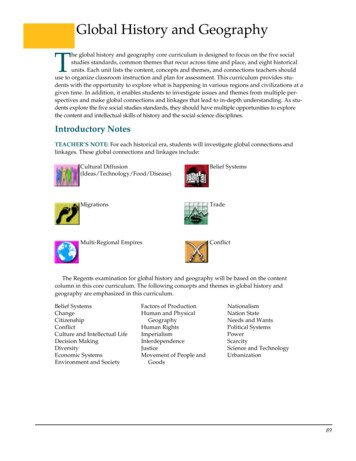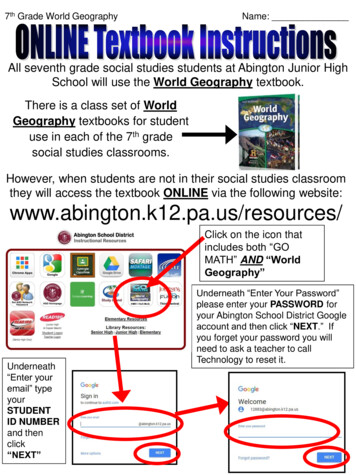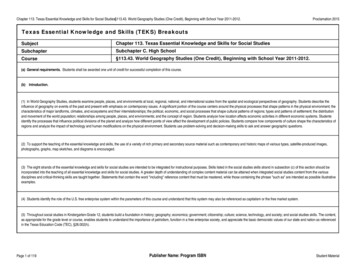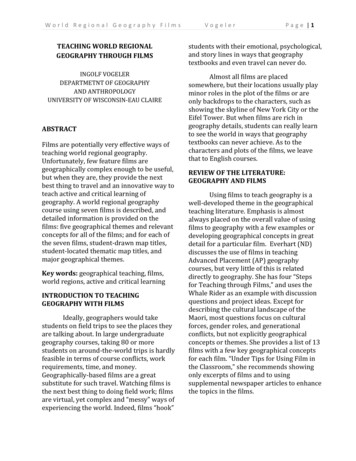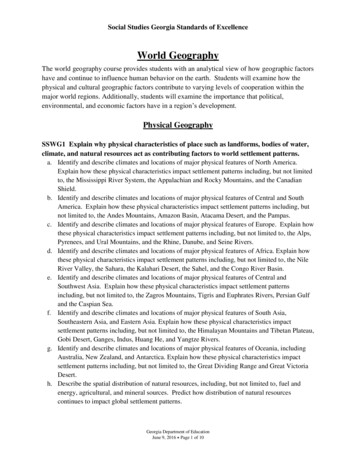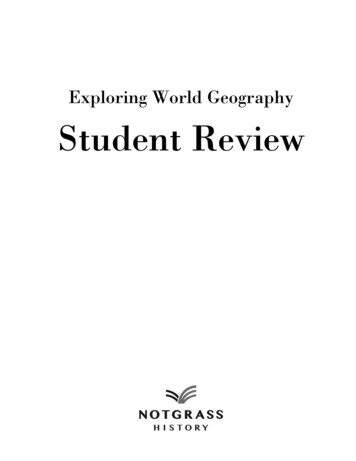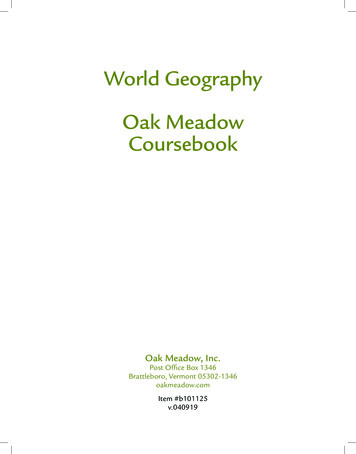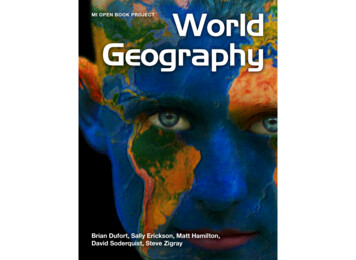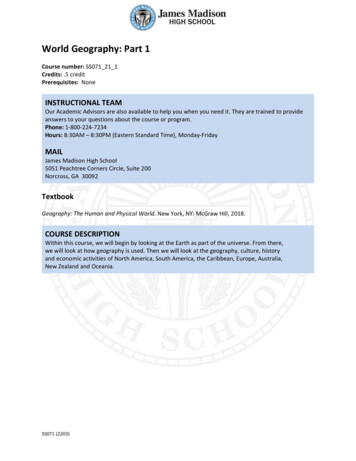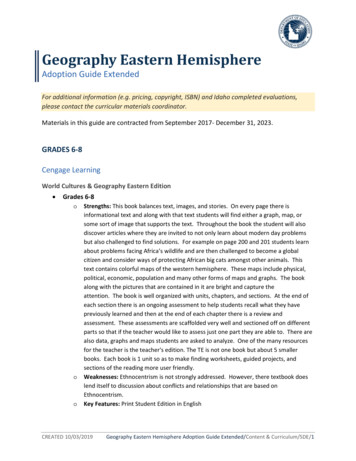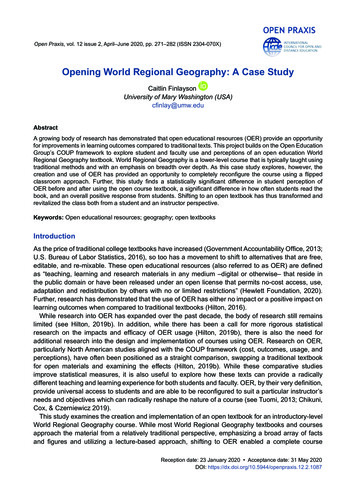
Transcription
Open Praxis, vol. 12 issue 2, April–June 2020, pp. 271–282 (ISSN 2304-070X)Opening World Regional Geography: A Case StudyCaitlin FinlaysonUniversity of Mary Washington (USA)cfinlay@umw.eduAbstractA growing body of research has demonstrated that open educational resources (OER) provide an opportunityfor improvements in learning outcomes compared to traditional texts. This project builds on the Open EducationGroup’s COUP framework to explore student and faculty use and perceptions of an open education WorldRegional Geography textbook. World Regional Geography is a lower-level course that is typically taught usingtraditional methods and with an emphasis on breadth over depth. As this case study explores, however, thecreation and use of OER has provided an opportunity to completely reconfigure the course using a flippedclassroom approach. Further, this study finds a statistically significant difference in student perception ofOER before and after using the open course textbook, a significant difference in how often students read thebook, and an overall positive response from students. Shifting to an open textbook has thus transformed andrevitalized the class both from a student and an instructor perspective.Keywords: Open educational resources; geography; open textbooksIntroductionAs the price of traditional college textbooks have increased (Government Accountability Office, 2013;U.S. Bureau of Labor Statistics, 2016), so too has a movement to shift to alternatives that are free,editable, and re-mixable. These open educational resources (also referred to as OER) are definedas “teaching, learning and research materials in any medium –digital or otherwise– that reside inthe public domain or have been released under an open license that permits no-cost access, use,adaptation and redistribution by others with no or limited restrictions” (Hewlett Foundation, 2020).Further, research has demonstrated that the use of OER has either no impact or a positive impact onlearning outcomes when compared to traditional textbooks (Hilton, 2016).While research into OER has expanded over the past decade, the body of research still remainslimited (see Hilton, 2019b). In addition, while there has been a call for more rigorous statisticalresearch on the impacts and efficacy of OER usage (Hilton, 2019b), there is also the need foradditional research into the design and implementation of courses using OER. Research on OER,particularly North American studies aligned with the COUP framework (cost, outcomes, usage, andperceptions), have often been positioned as a straight comparison, swapping a traditional textbookfor open materials and examining the effects (Hilton, 2019b). While these comparative studiesimprove statistical measures, it is also useful to explore how these texts can provide a radicallydifferent teaching and learning experience for both students and faculty. OER, by their very definition,provide universal access to students and are able to be reconfigured to suit a particular instructor’sneeds and objectives which can radically reshape the nature of a course (see Tuomi, 2013; Chikuni,Cox, & Czerniewicz 2019).This study examines the creation and implementation of an open textbook for an introductory-levelWorld Regional Geography course. While most World Regional Geography textbooks and coursesapproach the material from a relatively traditional perspective, emphasizing a broad array of factsand figures and utilizing a lecture-based approach, shifting to OER enabled a complete courseReception date: 23 January 2020 Acceptance date: 31 May 2020DOI: https://dx.doi.org/10.5944/openpraxis.12.2.1087
272Caitlin Finlaysonredesign and the adoption of a flipped-classroom model. Students have responded positively tothese changes and overall the use of OER has revitalized the course.Literature ReviewAcross the United States, textbook cost increases have outpaced the inflation rate, with pricesrising an average of 6 percent per year from 2002 to 2012 (Government Accountability Office,2013). These high costs can have a significant impact on students in a variety of ways. Whenexploring the impacts of textbook costs on course outcomes, Jhangiani and Jhangiani (2017)found that students reported taking fewer courses, not registering for a course, or withdrawingfrom a course as a result of textbook costs. Thirty percent of respondents in the study reportedearning a lower grade as a result of the cost of textbooks (Jhangiani & Jhangiani, 2017). Whiletextbooks are central facet of a college course experience, a 2012 survey of students in Floridafound that 64% of student respondents reported not purchasing a required textbook due to its cost(Florida Virtual Campus, 2012).Open educational resources thus provide a way for instructors to mitigate these cost challengeswhile providing increased access for students. Research shows that this increased access cansignificantly improve student grades and withdrawal rates (Feldstein et al., 2012). Course passrates were similarly shown to increase in a study examining a basic bath course (Pawlyshyn,Braddlee, Casper & Miller, 2013). Even if exam scores or grades remained the same as a varietyof studies have shown (see Lovett, Meyer, & Thille, 2008; Wiley, Hilton III, Ellington & Hall, 2012;Hendricks, Reinsberg & Rieger, 2017), the cost savings of using OER texts can be substantial. Inthe Hendricks, Reinsberg and Rieger (2017) study of a physics course in Canada, for example,just one year of OER use saved the students 85,000 (Canadian dollars). This study complementsprevious research by examining the impact of the use of an open textbook over the course of asemester on student perception and by providing a comprehensive case study on the writing,implementation, and effectiveness of an open textbook. Furthermore, this study presents astatistical analysis of student use and perceptions that is sometimes missing from more anecdotalcase studies.Open educational resources (OER) are characterized as “teaching, learning, and researchresources that reside in the public domain or have been released under an intellectual propertylicense that permits their free use or re-purposing by others” (Atkins, Brown, & Hammond, 2007, p. 4).While textbooks are perhaps the most commonly cited open educational resource, they also includemodules, notes, software, and other course materials (Atkins et al., 2007). Furthermore, althoughan awareness of open educational materials among instructors has grown considerably over thepast few years, it still remains relatively low, with less than half of faculty reporting an awareness ofOER materials (Seaman & Seaman, 2018). Peer-reviewed research on OER, while also expanding,remains limited (Hilton, 2019a).That said, the Open Education Group is seeking to further OER research using its COUPframework, which refers to research into the cost, outcomes, usage, and perceptions of OERmaterials (Open Education Group, n.d.). Much of the evidence-based research on OER can begrouped into these four areas and this project takes a similar approach, primarily exploring thecategories of student usage and perceptions using both quantitative, statistical analysis as wellas a qualitative approach.When comparing the perception of the quality of open textbooks versus traditional textbooks,the literature shows that the vast majority of students report open textbooks to be of the same orbetter quality than the commercial textbooks they have used. Bliss, Hilton III, Wiley and ThanosOpen Praxis, vol. 12 issue 2, April–June 2020, pp. 271–282
Opening World Regional Geography: A Case Study273(2013) reported that 94% of 490 students said they found open textbooks to be of equal or higherquality than traditional textbooks. Illowsky, Hilton III, Whiting and Ackerman (2016) reported ontwo surveys of students using an open textbook at a U.S. community college, one in 2013 of 231students and one in 2015 of 94 students (the students surveyed in 2015 used a significantlyrevised version of the textbook the students in 2013 had used). In the 2013 survey, 87% ofstudents rated the quality of the open textbook to be the same or better when compared totraditional textbooks, and in the 2015 survey, 93% of student respondents did so. In a survey ofover 300 students in British Columbia, 63% of respondents said the quality of the open textbookused in their course was “above average” or “excellent,” with another 33% rating the quality as“average” (Jhangiani & Jhangiani, 2017). Illowsky et al. (2016) similarly found 87% of studentsusing an open statistics textbook rated it equal or better than a traditional text. Faculty similarlyhad positive views, with one study finding that 50% of faculty perceived the OER text as the samequality as traditional textbooks and 33% finding that it was better (Hilton et al., 2013). Much ofthe research on student perceptions focuses on either student feedback after having used openmaterials, or a more controlled study where students compare and rate a traditional textbookversus an open text (see Hilton, 2019a).Another limitation of much of the existing research on OER is that traditional textbooks canbe more well-suited to traditional learning goals and assessment, such as multiple-choice tests.Open textbooks, however, can be pedagogically freeing for both instructors and students, enablinginstructors to reshape learning objectives and assessment metrics around entirely different goals.Research into open pedagogy have more explicitly explored these new educational landscapes,critically examining how open educational resources have enabled what could be termed “openpedagogy” (see Hegarty 2015; Wiley & Hilton, 2018) or open educational practices (OEP) (seeCronin 2017; Cronin & MacLaren 2018). Others like Weller et al. (2015) indicated that instructors areindeed more likely to innovate and experiment with their course instruction as a result of using OER.This study builds upon these foundations to examine how open educational materials could be usedto enable a completely redesigned course and explores both the faculty and student perspective onhow those changes impacted the teaching and learning experience.History and Background of World Regional GeographyAt most universities, World Regional Geography is an introductory-level general education coursetypically taken by both Geography majors and a wide array of non-majors. It is famously a challengingcourse to teach, as a 2019 session at the annual meeting of the American Association of Geographerscan attest to: “Teach the World, No problem: Challenges to Teaching World Regional Geography inOne Semester.” The breadth of the course, covering in theory the entirety of the world’s people inplaces in one semester, combined with the vastly different interest and experience levels of studentsin the course can present a significant obstacle for instructors. Compounding this issue, typical WorldRegional Geography textbooks emphasize breadth over depth, providing a somewhat repetitivepresentation of various facets of each world region, to include its key physical geographic features,political geography, economics, culture, and so on. For instructors, the course can feel a bit liketeaching the encyclopedia, conveying a list of facts about the world with little over-arching structureor connections between places.Further, for students this approach of broad, place-based geographic knowledge closely aligns withhow geography is taught at the primary and secondary levels in United States public schools. Mapquizzes are common in K-12 settings and are traditionally a feature of World Regional Geographycourses at the college level as well. For professional geographers, though, it is the connectionsOpen Praxis, vol. 12 issue 2, April–June 2020, pp. 271–282
274Caitlin Finlaysonbetween places and a deeper spatial understanding that is of critical importance. What this amountsto, then, is presenting students with a novice-level approach to geography rather than how expertsunderstand the discipline.Within the Department of Geography at the University of Mary Washington, individual instructorshave significant freedom to design and teach their courses and there is only one instructor, theauthor of this research paper, who teaches World Regional Geography every semester. Thus, itwas the instructor’s decision, in consultation with the department chair, to shift to a team-basedlearning approach. Team-based learning provided a research-backed foundational structure(see Michaelsen, Knight, & Fink 2002) for shifting from a lecture-based approach to a problembased approach where students could work in small groups to discuss and solve complex globalissues. However, the traditional format of most World Regional Geography textbooks presented animpediment to “flipping” the course since they emphasized facts about specific regions rather thanconnections between places or larger global problems. Furthermore, students routinely commentedthat they were overwhelmed by the amount of information in the traditional World Regional text, andthus assigning additional news articles on top of the textbook reading, which students could thenuse in application activities, would be challenging.Thus, the open textbook World Regional Geography was developed during the summer of 2016 asan alternative to more traditional geography textbooks on the market. Rather than present a broadarray of information about specific places, this text emphasizes depth over breadth, focusing on adifferent key concept in geography for each of the world’s regions. The broad concepts of globalizationand inequality are woven through each chapter, providing a more cohesive overall structure. WorldRegional Geography is also more concise than traditional texts, containing ten chapters rather thanthe more typical fourteen or fifteen, which more closely aligns with the team-based learning formatand enables instructors the flexibility to assign additional readings. The text was developed to beopenly and freely accessible in support of the American Association of Geographer’s initiative tobroaden participation in the discipline of geography (American Association of Geographers, n.d.).If students couldn’t even access the textbook at the introductory undergraduate level, how wouldthey go on to be active participants in the field? Providing an open and free textbook was one way toremove an early barrier to the discipline.World Regional Geography was initially written and compiled using LaTeX, a typesettingprogramming language which is available for free at https://www.latex-project.org/, and postedonline in both PDF and HTML format on the author’s personal domain. In the summer of 2019, theonline version was shifted to Pressbooks (at https://worldgeo.pressbooks.com/) in order to makethe text more accessible for students with disabilities. Pressbooks (https://pressbooks.com/) is builton Wordpress and shares its accessibility features, such as supporting screen readers and the useof alternative text. It is free to create a Pressbook, though there is a one-time cost to “publish” thebook and make it available to others. At the time of this publication, the cost was 19.99 (USD) topublish an eBook or 99 (USD) to create both a eBook and generate a PDF. Again, this was a onetime cost and there are no additional charges to make edits or changes. Pressbooks also supportsexporting the text in other formats compatible with print-on-demand services, so World RegionalGeography is now offered as a color print edition on Amazon and Kindle through Amazon’s KindleDirect Publishing program (https://kdp.amazon.com). World Regional Geography was publishedunder the Creative Commons Attribution-NonCommercial-ShareAlike 4.0 International PublicLicense /). There are a variety of licenses offeredby the Creative Commons non-profit organization and this particular one was selected because itallows non-commercial re-use as long as the material is attributed and shared openly. Since its initialOpen Praxis, vol. 12 issue 2, April–June 2020, pp. 271–282
Opening World Regional Geography: A Case Study275publication, World Regional Geography has been downloaded over 18,000 times in over 30 countries.The Pressbooks version of the text has been visited by over 2,800 active users since its posting insummer 2019. It has also been adopted by a number of universities and community colleges. At theUniversity of Mary Washington alone, adopting an open textbook represents a potential cost savingsto students of 84,000 over the past four years.MethodsThis study was conducted beginning in the Fall 2018 semester and continuing to the Spring2019 semester in two different sections of a World Regional Geography course at the Universityof Mary Washington. The University of Mary Washington is public liberal arts university locatedin Fredericksburg, Virginia. The university has approximately 4,800 students, most of whom areundergraduates (around 4,400) and most of whom are full-time (88%). Of the full-time undergraduatestudents in academic year 2018–2019, 68% applied for need-based financial aid and 32% receivedneed-based scholarship or grant aid (University of Mary Washington, 2019).This class used team-based learning, a form of “flipping” the classroom where students come toclass having completed the assigned reading, take a quiz to check their knowledge, and then workin groups to discuss and solve complex problems. Each section of the course had the same basiccontent, assignments, exams, and delivery format and used the same textbook, an open WorldRegional Geography textbook written by the instructor and implemented in Fall 2016. Each coursehad approximately 70 students enrolled and met face-to-face three times each week. Students wereasked to complete an anonymous pre-semester, mid-semester, and end-of-semester survey todetermine their perceptions and use of the textbook and course format.Student SurveyBeginning in Fall 2016, a relatively brief survey was developed by the instructor to gauge initialstudent interest in the course material, delivery format, and the textbook at the start of the coursewith additional surveys at the mid-semester point and at the end of the semester. These surveyswere anonymous and were disseminated using Canvas, our institutional course managementsystem. In early versions of the survey, the focus was primarily on team-based learning and onwhether students preferred a printed or electronic textbook. As this research project evolved,additional questions were added in Fall 2018 specifically examining student use and perceptionsof the open textbook in more detail utilizing the examples provided in the open education toolkit(http://openedgroup.org/toolkit) which builds on research by Bliss et al. (2013). For example,students were asked, “How would you rate the quality of free, open access textbooks comparedto traditional course texts?” As in the study by Illowsky et al. (2016), students were not provideda definition for what would constitute a “quality” textbook and instead this question was left opento students to interpret. These additional questions regarding specific issues related to studentperception and textbook use are the focus of this study. The core questions regarding team-basedlearning and interest in the course material were also used in the later version of the survey. Atotal of 136 students responded to the pre-semester surveys during the Fall 2018 and Spring 2019semesters and 116 responded to the end-of-semester survey. These results were analyzed usingSPSS Statistics 24, a statistical analysis software package. Since these surveys were anonymous,independent t-tests rather than paired t-tests were utilized, a limitation with this type of anonymousresearch (Warne, 2018).Open Praxis, vol. 12 issue 2, April–June 2020, pp. 271–282
Caitlin Finlayson276ResultsStudent AccessAs discussed, this textbook was provided freely and openly online. In addition, a black-and-whiteprinted, spiral-bound version was offered at the University of Mary Washington campus bookstorefor 15. Perhaps surprisingly, most students (N 79, 69%) responded that they purchased a printedtextbook (see Table 1).Table 1: How did you access the textbook for this class? (Please select all that apply.)Access MethodNPercentage of all respondentsPDF or HTML Viewed Online4035%Downloaded PDF or HTML3530%Purchased a printed textbook7969%Total Respondents115This speaks to research from the National Association of College Stores which found that mostcollege students prefer printed textbooks over digital versions (NACS, 2014). In addition, the highpercentage of students downloading or viewing a web version connects to the importance of ensuringaccessibility to all learners, which can sometimes be a problem with OER materials (see Navarrete& Luján-Mora, 2018).Student Perception of QualitySeveral questions were developed to determine student perceptions of the quality of the opentextbook. Since the textbook was developed specifically with the intention of having an accessibleand conversational writing style, students were asked to rate the statement, “The writing style of thetextbook and its approach has enhanced my understanding of the course material,” using a five-pointLikert scale ranging from Strongly Disagree to Strongly Agree. Students overwhelmingly agreedwith this statement, with 92% reporting either “Agree” or “Strongly Agree” (see Table 2). Instructorsconsidering authoring OER texts might feel they would be unable to match a traditional textbook’sstately writing style, but it would seem that a more accessible and conversational tone is valued bystudents and perhaps an instructor’s goal could simply be to allow their own voice to shine through.Table 2: The writing style of the textbook and its approach has enhanced my understanding of the course materialRatingNPercentage of all respondentsStrongly Disagree00%Disagree11%Neutral87%Agree5245%Strongly Agree5547%116100%Total RespondentsOpen Praxis, vol. 12 issue 2, April–June 2020, pp. 271–282
Opening World Regional Geography: A Case Study277A more general concern was overall student perception of open educational resources and howusing these resources impacted their perception. At the beginning of the semester, students wereasked, “How would you rate the quality of free, open access textbooks compared to traditional coursetexts?” and this question was repeated at the end of the semester. Students could select whetheropen textbooks were worse than, about the same as, or better than traditional textbooks.At the beginning of the semester, about half of students rated open textbooks as about the sameas traditional textbooks (see Table 3). By the end of the semester, over 80% of students rated opentextbooks as better than traditional textbooks.Table 3: How would you rate the quality of free, open accesstextbooks compared to traditional course texts?Pre-SemesterRatingNOpen textbooks are WORSE than traditional textbooks%End-of-SemesterN%43%22%Open textbooks are ABOUT THE SAME as traditional textbooks6850%1917%Open textbooks are BETTER than traditional textbooks6447%9482%136100%115100%TotalA t-test for independent samples can be utilized to determine whether or not this difference inthe perception of quality is statistically significant. Before conducting the t-test, the homogeneityof variance was tested to determine if the variance within the two groups was equal. The result ofLevene’s test for equality of variances was significant (p .01) and thus the variances are not equal.A t-test was calculated based on unequal variances and the result was highly significant (t 5.594,p .001). The practical significance of the difference was then analyzed using Cohen’s d yieldinga value of .696, which is considered to be a medium effect size. In general, an effect size of .2is considered small, .5 is considered medium, and .8 is considered large (Cohen, 1988). In otherwords, there is both a statistically significant and practically significant difference between studentperception of open textbook quality before and after using an open textbook.Students were given an opportunity to provide general comments at the end of both the pre- andpost-semester surveys. This course utilized a team-based learning format which was unfamiliar tomany students, so much of the comments expressed concern about the particular course structure.Of the pre-semester comments, few discussed perceptions of the textbook’s quality. Only one, forexample, directly compared the text to another OER text used previously:“The course textbook seems to be of much better quality than the open textbook I used for a mathclass last semester.”Others based their perception of quality on the instructor’s in-class framing of the textbook and howit was developed:“I love that we are going to learn out of a textbook that gives you exactly what you need to know anddoes not give you un needed super detailed material to mess you up.”“I really like how instead of using a traditional textbook with lots of information we won’t use, youcreated your own book to concentrate on the information you deem important.”Open Praxis, vol. 12 issue 2, April–June 2020, pp. 271–282
278Caitlin FinlaysonThe in-class discussion of how the textbook differed from traditional World Regional Geographytexts, taking a concise approach rather than presenting a broad survey of geographic information,was clearly reflected in how students approached the text.At the end of the semester, students were overwhelmingly positive about the textbook, with onlyone negative comment:“I think the textbook was somewhat dry at times but there isn’t really anything that can be doneabout that.”All of the other comments on the textbook were positive, for example:“I really enjoyed the textbook. The language is easy to comprehend, not so much that it’s like ‘easy,’but I understood what was being said even though I’ve never taken a geography class before this.It was also an extremely interesting textbook!”“The textbook was absolutely wonderful compared to some other textbooks that I’ve had to use.”“This was the best class textbook I have ever used. Information was well-written and easy to read.Unlike traditional textbooks that are unrelated to a specific class, this textbook did not includeextraneous information. Therefore, I read each chapter to completion, rather than skimming orskipping reading altogether.”“The textbook is well written and much more intriguing than a traditional book.”Before authoring and adopting the open text, previous university-wide course evaluation commentsrarely included mentions of the textbook, and when the textbook was discussed, it was generallynegative. Overall, student perception of the quality of the textbook was positive, particularly after usingthe book throughout the semester and understanding more about its development and approach.Student Use and FrequencyAt the beginning of each semester, students were asked how often they use the required course textsin a typical course. Consistent with previous research (see Burchfield & Sappington, 2000; Clump,Bauer, & Bradley, 2004), students are not using required textbooks as much as instructors mightthink and this can have significant impacts on learning outcomes. Around two-thirds of respondentsreported using the required texts frequently, two to three times each week or more (see Table 4). Tenpercent of respondents reported only using the required texts two to three times each semester, andfour respondents never used the required texts at all.Table 4: For a typical course, how often do you use the required texts?Frequency of UseNeverNPercentage of all respondents43%2-3 Times a Semester1310%2-3 Times a Month2821%2-3 Times a Week7958%Daily129%136100%Total RespondentsOpen Praxis, vol. 12 issue 2, April–June 2020, pp. 271–282
Opening World Regional Geography: A Case Study279At the end of the semester, students were asked the same question but about the World RegionalGeography textbook, and results were noticeably different. 85% of respondents reported using theWorld Regional text two to three times each week or more, with no respondents reporting that theynever used it (see Table 5).Table 5: For this course, how often did you use the required text?Frequency of UseNPercentage of all respondentsNever00%2-3 Times a Semester11%2-3 Times a Month1614%2-3 Times a Week9178%87%116100%DailyTotal RespondentsThese differences were then tested using an independent-samples t-test. The results of Levene’stest for homogeneity of variance was significant (p .01), meaning that the variance between thegroups was not equal, so a t-test was calculated based on the assumption of unequal variance.There was a significant difference between how often students used the required texts in a typicalcourse compared to how often used the required text in World Regional Geography (t 3.511,p .01). This difference further analyzed using Cohen’s d, yielding a value of .433, or a small tomedium effect size.Student comments pre-semester expressed a general appreciation for the free online textbook:“I really appreciate that it is available online for free, as textbook costs can add up quick.”“The times that I’ve used a textbook written by the professor of the course, the textbook seemedmuch more relevant and I enjoyed (and used) the textbook way more.”Other students appreciated having access to a low-cost printed version:“I’m very excited that the textbook is not expensive in the bookstore and there is an online versionfor free!”Another expressed frustration that the textbook was not available at online retailers:“It would be been more convenient if the textbook was available on Amazon.”As a result of the high percentage of students who purchased a printed version of the textbook, andthe generally low quality of the black-and-white spiral version,
Regional Geography textbook. World Regional Geography is a lower-level course that is typically taught using traditional methods and with an emphasis on breadth over depth. As this case study explores, however, the creation and use of OER has provided an opportu
